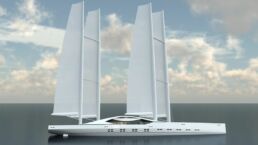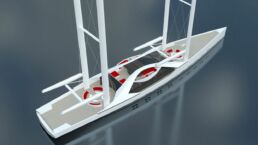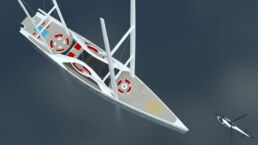Mathis Rühl presents a vision with the revolutionary Multiple Rotating Twin Wingmast on his project R77
The design brief of the R77 was to create a 77m sailing yacht with Panamax height. The result is a sailing yacht concept with the Multiple Rotating Twin Wingmast that has an air draft of 62.5m.
Could the project R77 an example for commercial shipping with sails?
“Furthermore, we see this rig concept as an interesting option for commercial vessels application. If oil price is actually excessively low, making such investigations appearing not directly profitable, we have to keep I mind that the real issue is much bigger and concerns us all. Besides, fossil oil is a much too precious resource to just burn it, when the wind offers us its innocuous, unlimited and beautiful energy.”. – Mathis Rühl
Multiple Rotating Twin Wingmast (MRTW)
Mathis Rühl started the developing of the rig from scratch. The whole running and standing rigging are focused on the rotating platforms. The forestay is very short and offers a helipad on this sailing yacht.
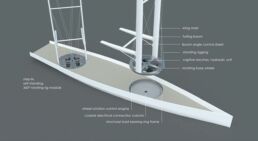
Advantages and Disadvantages of different rig types
The designer compared the different rig types Sloop, Schooner, Dyna Rig, Ketch and the Multiple Rotating Twin Wingmast on large sailing yachts. The Dyna and Schooner rig are the ones that would meet the Panamax height requirement but with too many disadvantages.
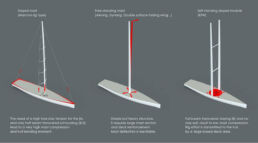

+ Upwind performance
– Redhibitory air draft
– Gybing maneuver
– Sail handling
+ Air draft
+ Reaching performances
– Upwind performances
– Downwind performances
+ Air draft
+ Automated sail handling
+ Gybing maneuver
+ Clean deck plan
– Upwind performances
– Tacking maneuver
– Bad reefed configuration in strong wind
– No emergency release
– Symmetrical non-optimal sail profiles
– No (or wrong way) vertical twist
– High windage (motoring and mooring)
– Heavy and high Vertical of Gravity
+ All around sail performances
– Sail handling (gennaker)
– Gybing maneuver
– Air draft issue
Summary of advantages
+ Fully automated
+ Easy taking
+ Easy gybing
+ Limited air draft
+ No downwind sail needed
+ Self-standing rig modules
+ Known mast, boom and sail technology
+ No forestay or backstay to realize a helipad
+ Emergency quick release
+ No visual jib
+ In case of engine problems, the boat can be fully maneuvered with sole sails (stopping, going backward and pivoting)
– Specific deck layout
– Specific superstructure design
– Rotating base wheel (additional weight and volume
Profile
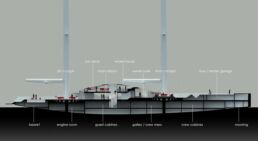
SHARING IS CARING - THANK YOU!
About Publisher
 Ahoy, I’m René, the “captain” of this luxury yacht blog, and found my passion for the big ones at the age of 17. I have grown up with sailing since a little child. I have an education in Business Informatics and specialized in digital media solutions (alongside luxury yachts) like Online-Marketing, User Experience Design et cetera. My home port is in Oldenburg, Germany next to Lürssen and Abeking & Rasmussen. More about yachtemoceans
Ahoy, I’m René, the “captain” of this luxury yacht blog, and found my passion for the big ones at the age of 17. I have grown up with sailing since a little child. I have an education in Business Informatics and specialized in digital media solutions (alongside luxury yachts) like Online-Marketing, User Experience Design et cetera. My home port is in Oldenburg, Germany next to Lürssen and Abeking & Rasmussen. More about yachtemoceans
